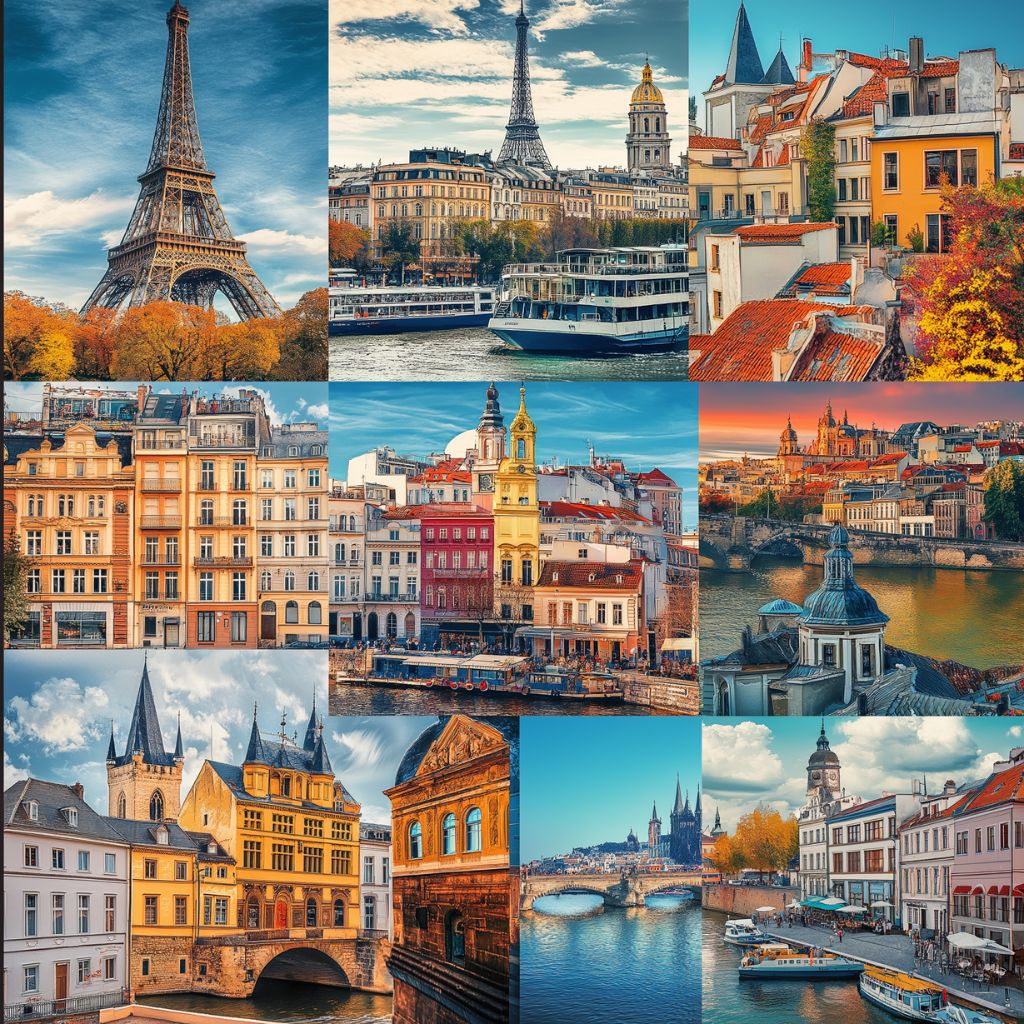Your Complete Guide to Traveling Through Europe: Top Destinations, Routes & Insider Tips
Table of Contents
Introduction
Have you ever dreamed of sipping espresso in Rome, wandering through cobbled streets in Prague, or watching the Northern Lights dance over Norway? If so, you’re not alone. Europe remains one of the world’s top travel destinations, with over 585 million international visitors annually, according to the European Travel Commission.
With its dense network of countries, rich cultural diversity, and efficient transport systems, Europe is ideal for multi-country travel—whether you’re a first-timer or a seasoned explorer.
But planning a European itinerary can be overwhelming: Where should you start? How many countries should you visit? What’s the best way to get around?
In this guide, we break it all down for you. From the must-see destinations to transportation insights, seasonal recommendations, and money-saving tips, this post will help you map out a trip that’s both memorable and manageable.
In-Depth Outline
1. Planning Your Route Through Europe
- Consider geographic flow: Western, Central, and Eastern Europe.
- Use travel hubs like Paris, Berlin, or Amsterdam as starting points.
- Group countries by proximity (e.g., France–Switzerland–Italy).
Table: Sample 2–3 Week Itineraries
| Duration | Region Covered | Cities Included |
| 2 Weeks | Western Europe | Paris, Amsterdam, Brussels, London |
| 3 Weeks | Central & Eastern Europe | Prague, Vienna, Budapest, Kraków |
| 3 Weeks | Mediterranean Route | Barcelona, Nice, Rome, Florence |
2. Must-Visit European Cities and Why

- Paris, France: Art, architecture, and cuisine.
- Barcelona, Spain: Gaudí’s legacy, tapas culture, beach vibe.
- Budapest, Hungary: Thermal baths, ruin bars, affordability.
- Copenhagen, Denmark: Sustainability and design haven.
Table: Destination Highlights
| City | Known For | Best Time to Visit |
| Rome | Ancient ruins, Italian cuisine | April–June, Sept–Oct |
| Amsterdam | Canals, museums, bike culture | May–September |
| Prague | Gothic charm, castles, affordability | Spring or early Fall |
3. Getting Around Europe Efficiently

- Use high-speed trains (Eurail, TGV, ICE) for intra-country travel.
- Budget airlines like Ryanair or easyJet for longer hops.
- Rent a car for scenic countryside routes (e.g., Tuscany or the Alps).
Table: Transport Method Comparison
| Transport Type | Pros | Cons |
| Trains | Scenic, comfortable, city-center to city-center | Can be costly without a pass |
| Budget Flights | Fast for long distances | Baggage fees, remote airports |
| Rental Car | Freedom to explore small towns | Toll roads, parking challenges |
4. Seasonal Travel Tips: When to Go
- Spring (April–June): Fewer crowds, mild weather.
- Summer (July–August): Festivals and long days, but more tourists.
- Fall (Sept–Oct): Lower prices, rich autumn colors.
- Winter (Nov–Feb): Christmas markets, ski trips, fewer crowds.
5. Budgeting for Your European Adventure

- Daily budget ranges: €50–150 depending on city and travel style.
- Use city passes (e.g., Paris Pass, Vienna Card) for attraction access.
- Stay in boutique hotels, Airbnbs, or hostels for value.
Table: Estimated Daily Budget by City
| City | Budget Traveler (€) | Mid-Range Traveler (€) |
| Berlin | 60 | 120 |
| Rome | 70 | 130 |
| Prague | 50 | 100 |
6. Cultural Insights and Etiquette

- Greet in local language (even a simple “hello” goes far).
- Be mindful of tipping customs: not all countries expect it.
- Dress modestly in churches and religious sites.
7. Travel Tech & Apps to Use
- Rome2Rio for transport planning.
- Google Translate for quick language help.
- Maps.me or Google Maps for offline navigation.
- Splitwise for group expense sharing.
8. Safety and Travel Documents

- Schengen Visa requirements for non-EU travelers.
- Carry both digital and physical copies of documents.
- Use a money belt or anti-theft backpack in tourist zones.
Detailed Content Expansion
1. Planning Your Route Through Europe
Mapping out your European itinerary is all about balancing time, geography, and interests. With 44 countries to choose from, it’s tempting to pack in as many as possible—but less is often more. Focus on a region and build your route logically.
Start with a hub: Major cities like Paris, London, Amsterdam, or Frankfurt have large international airports and excellent train connections. From there, you can branch out based on your preferences—whether you want historical cities, beach towns, or scenic mountain villages.
When grouping destinations, consider proximity and transportation ease. For example:
- Western Europe route: Paris → Brussels → Amsterdam → London.
- Central Europe route: Prague → Vienna → Budapest → Bratislava.
- Mediterranean route: Barcelona → Nice → Florence → Rome.
Table: Sample 2–3 Week Itineraries
| Duration | Region Covered | Cities Included |
| 2 Weeks | Western Europe | Paris, Amsterdam, Brussels, London |
| 3 Weeks | Central & Eastern Europe | Prague, Vienna, Budapest, Kraków |
| 3 Weeks | Mediterranean Route | Barcelona, Nice, Rome, Florence |
Tips:
- Avoid one-night stops—spend at least 2–3 nights per city.
- Use trains for regional travel; flights only if cities are far apart.
- Schedule “down days” to rest or explore off the beaten path.
Proper planning allows you to enjoy each destination rather than rush through a checklist.
3. Getting Around Europe Efficiently
Europe boasts one of the world’s most efficient and traveler-friendly transport networks. Whether you’re hopping between major capitals or venturing into the countryside, there’s a smart way to do it.
Train Travel
Train systems in Europe are renowned for their speed, frequency, and comfort. The Eurail Pass is ideal for multi-country trips, while individual country passes (like the Swiss Travel Pass) offer great value domestically. High-speed trains (like France’s TGV or Germany’s ICE) cut travel times significantly.
Budget Flights
For longer distances—say, Berlin to Rome—a budget airline like Ryanair or Wizz Air may be the most efficient option. But beware of extra costs: checked baggage, airport transfers, and seating fees add up. Also, some budget airports (like Paris Beauvais or London Stansted) are located far from city centers.
Driving
In rural regions like Provence, Tuscany, or Bavaria, renting a car gives you freedom to explore vineyards, villages, and scenic byways. Just be aware of tolls, roundabouts, and parking availability in older towns.
Table: Transport Method Comparison
| Transport Type | Pros | Cons |
| Trains | Scenic, comfortable, city-center to city-center | Can be costly without a pass |
| Budget Flights | Fast for long distances | Baggage fees, remote airports |
| Rental Car | Freedom to explore small towns | Toll roads, parking challenges |
Expert Tip: Always compare travel times, convenience, and costs when choosing between trains and flights. A 1-hour flight may equal 4+ hours when factoring in airport transfers and security.
Conclusion
Traveling through Europe is one of the most rewarding experiences for any adventurer. With its tapestry of cultures, cuisines, and landscapes packed into a relatively compact continent, Europe offers something for every kind of traveler.
By planning a smart route, embracing local customs, and choosing the right modes of transportation, you’ll not only see the best of Europe—you’ll experience it deeply and meaningfully. Whether you’re sipping wine on a Parisian terrace or exploring the castles of Prague, your European journey is sure to become one of your most cherished memories.


